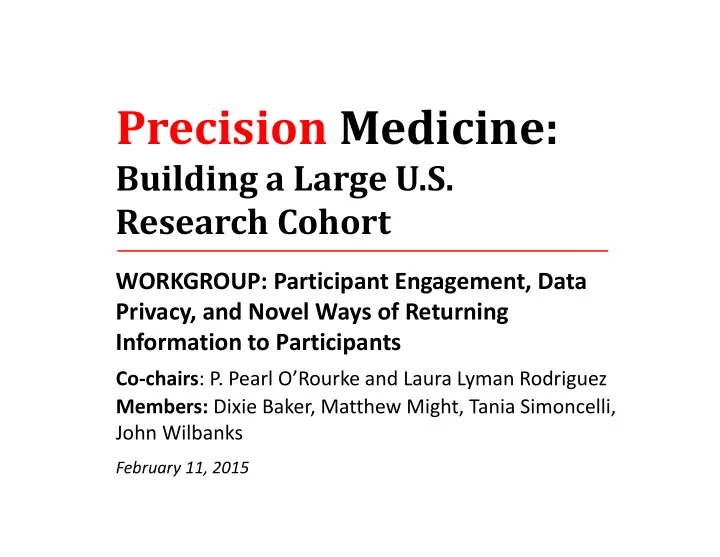

Precision Medicine: Building a Large U.S. Research Cohort WORKGROUP: Participant Engagement, Data Privacy, and Novel Ways of Returning Information to Participants Co ‐ chairs : P. Pearl O’Rourke and Laura Lyman Rodriguez Members: Dixie Baker, Matthew Might, Tania Simoncelli, John Wilbanks February 11, 2015
Current New Landscape “…[patients are] not going to be on the sidelines. It’s not going to be an afterthought. They’ll help us design this initiative from the ground up, making sure that we harness new technologies and opportunities in a responsible way.” – President Obama, January 30 th Photo: Mandel Ngan/AFP
New Landscape Principles: • Participant ‐ centric in concept and design – Participant partners, included in all aspects with expertise, interests, and responsibilities • Heterogeneous healthcare delivery interfaces addressed • Transparent process that sustains public trust Needs: • Inclusive • Flexible • Resourced for sustainability
Overarching Challenge What is “it”? For example: • What are the specific goals and what will success be? • Who will be recruited and how? • What is expected of participants? And for how long? • How will participation be sustained? • How will healthcare providers be involved? • What will be optional? • What will participants receive? • How will date be collected, maintained and protected?
Broad Challenges • Managing the Research/Clinical Intersection • Engaging and sustaining ‘New’ and ‘Affiliated’ Participants • Policies, Regulations, and Laws
Research/Clinical Intersection • Boundaries between research and clinical are already being challenged • All parties meeting at the intersection (participants, clinicians, researchers, etc.) need clarity re: – Scope – Goals – Return of Results – Access, use, sharing – Participant and provider resources available throughout
Managing the Research/Clinical Intersection – Proposed Solutions • Develop adaptable “toolkits” for participants and providers • Establish an expert body (including participants and providers) to inform decisions regarding return of results • Provide transparent and updated expectations regarding coverage and payment for research tests, confirmatory tests, etc. • Provide resources and best practices for providers (useful whether or not involved in Cohort activities) • Ensure regular review of guiding policies and practices by an appropriate broad based governance body
Engaging ‘New’ and ‘Affiliated’ Participants • Respect individual values and preferences, allowing for change over time – Anticipate and address possible differences between ‘affiliated’ and ‘new’ participants • Enable variable levels of engagement • Establish clear information practices – For providing as well as receiving information • Define and address involvement of participants’ family members
Engaging ‘New’ and ‘Affiliated’ Participants – Proposed Solutions Governance: • Establish an overarching participant advisory group Recruitment: • Reach beyond traditional settings to increase diversity • Consult with existing cohort participants • Provide transparent information: basic and detailed • Define the ‘minimally viable data set’ vs ‘options’ • Innovate approaches to informed consent and privacy
Engaging ‘New’ and ‘Affiliated’ Participants – Proposed Solutions Maintaining Participant Involvement: • Use social media and other innovative modalities • Use technology to enable remote and “low cost” participation • Encourage multi ‐ platform accessibility and gamification of data collection technology Return of Results: • Provide individual ‐ level data relevant to health • Provide trend data and other information about individual participation through dashboards or participant portals • Ensure uniformity in resources across the cohort to providers and participants
Policies, Regulation, and Laws • Current research oversight process far from optimal for a large, distributed study • Privacy framework focuses on NOT sharing – Local, state, and federal laws overlap and vary by site – Data security and harmonization need more attention • FDA oversight will also be layered as health information is returned and used
Policies, Regulations, and Laws – Proposed Solutions • Streamline research oversight that maintains protection • Harmonize requirements for HIPAA and Common Rule • Address clear “liability” protections for participating entities • Establish standards for data provenance and rules for access that enable sharing (including direct participant sharing) • Incentivize development of procedures within EHRs that support privacy/security needs • Continuously update security standards and management practices to maintain “state of the art” approaches • Ensure ‘clean’ data transmission through mobile technologies • Create flexible pathways for FDA oversight and compliance
Opportunities • Responsibly advance genomics into precision care • Create a new paradigm for participant and provider engagement • Identify critical factors for successful participant engagement – Potential to advance ethics, biomedical, behavioral, and sociology studies • Develop new approaches for oversight that are responsive to large decentralized participant research • Advance learning health care processes
Summary • Challenges and possible solutions must be re ‐ examined in light of final detailed plans for the Cohort study • Our group emphasizes – The need to specifically address the research ‐ clinical intersection – and to include providers as well as participants in planning and implementation – The need to employ exciting technologies to not only recruit participants into the study, but to sustain their interest/engagement over time – The need to proactively address policies, regulations and laws that may obstruct the research • Our group also emphasizes: – Incredible opportunities for participants, providers and researchers
Acknowledgements Group Members: Dixie Baker, Ph.D., M.S, FHIMSS, Martin, Blanck & Associates Matthew Might, Ph.D., NGLY1.org P. Pearl O’Rourke, M.D., Partners HealthCare Laura Lyman Rodriguez, Ph.D., NHGRI/NIH John Wilbanks, Sage Bionetworks Special Thanks: Elyse Galloway, NHGRI/NIH
Recommend
More recommend